Summary
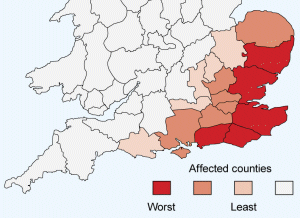
Relative amounts of damage to woodlands in the counties of south-east England
The storm that swept through the south-eastern corner of the British Isles during the early hours of 16th October was a memorable event that caused significant damage. The winds were unusually strong and the extent and severity of damage to woodlands and trees was greater than that typically caused by wind in the south of England.
Regeneration of broadleaved woodlands following the Great Storm of October 1987
1998 survey
An early survey carried-out at 45 sites in 15 locations during summer 1988 found that the number of tree seedlings present varied with site and species: all sites with ash seedlings present were adequately stocked but only a quarter of sites had large numbers of beech and oak seedlings. The results of the survey implied that natural regeneration would be successful at these sites.
2002 survey
A follow-up survey was made in 2002 to see how the woodlands had developed.
Most of the sites revisited had regenerated successfully, although the species present had changed. Ash remained abundant at sites where it was the dominant species in 1988, but birch had usually become dominant on sites where oak and beech had originally been abundant. This suggests that whilst natural regeneration can successfully recreate a woodland the species that arise may not always be those initially present.
For more details see:
Harmer, R., Tucker, N. and Nickerson, R. (2004). Natural regeneration in storm damaged woods – 1987 storm sites revisited (PDF-221K). Quarterly Journal of Forestry, 98, 183-190.
Regeneration of storm-damaged conifer woods following the Great Storm of October 1987
Wind damage and restoration of PAWS
The most recent studies have been carried-out to investigate whether the woodlands that have developed following the damage and clearance of planted conifer woodlands can help to improve guidance on the restoration of plantations on ancient woodland sites which are commonly known as PAWS. The current advice recommends that woodland cover should be maintained and conifers removed gradually from PAWS.
This contrasts dramatically with the processes caused by the storm. Conifer tree cover was destroyed overnight in a single catastrophic event with further disturbance to the sites caused by the clearance of fallen trees and debris.
New broadleaved woodlands on wind damaged PAWS
Surveys were made in 2006 of broadleaved woodlands that had regenerated naturally to replace storm damaged conifer plantations. The trees, shrubs and ground flora vegetation were observed to see if the plants present were typical of the native woodlands that would naturally occur on the sites.
Brief descriptions of some of the sites visited are given below (select from list or click on sites marked on map).
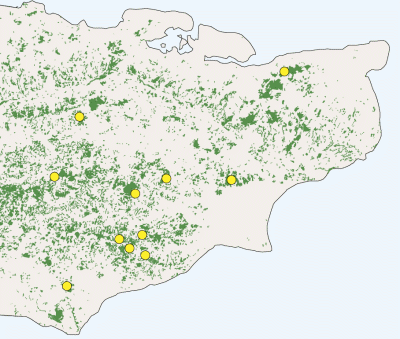
- Abbots Wood
- Ashes Wood
- Barnes Wood
- Battle Great Wood
- Birchden
- Clowes Wood
- Darwell
- Dene Park
- Hemsted
- Mopesden
- Orlestone
The sites were dominated by birch but the overall range of species present was typical of the broadleaved woodlands that would naturally occur. For more details see:
Harmer, R. and Morgan, G. (2009). Storm damage and the conversion of conifer plantations to native broadleaved woodland. Forest Ecology and Management, 258, 879-886.
Abbots Wood
Regeneration following Great Storm of October 1987
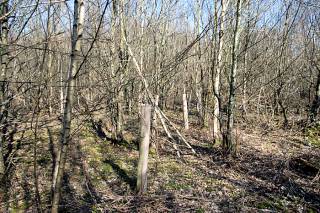
Several native species, including oak, have been planted to increase the variety of trees present.
- Grid reference: TQ 565 080
- Original conifer species: Corsican pine and Douglas fir
- Current trees: Similar amounts of birch and hornbeam (mostly from coppice shoots).
- Ground flora: Bramble, honeysuckle, bluebell and wood sage plus other grasses and herbs.
Ashes Wood
Regeneration following Great Storm of October 1987
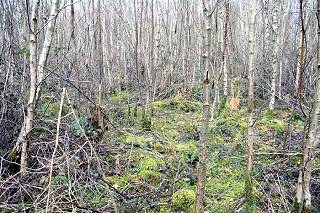
Mosses cover a significant part of the ground at this site.
- Grid reference: TQ 728 176
- Original conifer species: Western Hemlock
- Current trees: Birch with some oak and hornbeam coppice
- Ground flora: In addition to large areas of moss, bramble broad buckler fern and wood sage are frequent.
Barnes Wood
Regeneration following Great Storm of October 1987
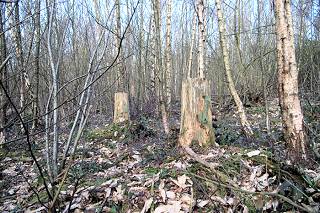
Decaying stumps of larch are still evident.
- Grid reference: TQ 762 204
- Original conifer species: European larch
- Current trees: Birch with some sweet chestnut and hornbeam coppice.
- Ground flora: Predominantly bramble, but broad buckler fern, bracken, bluebell and wood sage frequent.
Battle Great Wood
Regeneration following Great Storm of October 1987
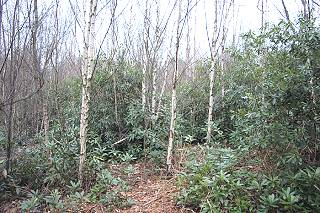
Rhododendron is a significant part of the shrub layer at this site.
- Grid reference: TQ 768 162
- Original conifer species: Mixture of western hemlock, Corsican pine and Japanese cedar
- Current trees: Birch with some oak and sweet chestnut coppice
- Ground flora: Bramble most common, but wood sage, broad buckler fern and bracken also frequent.
Birchden
Regeneration following Great Storm of October 1987

Large coppice stools such as this chestnut are frequently found in these storm damaged woods
- Grid reference: TQ 533 357
- Original conifer species: Mixture of Corsican pine, Douglas fir, western hemlock and Japanese cedar
- Current trees: Birch with some sweet chestnut coppice
- Ground flora: Mostly bramble and broad buckler fern, but bluebell and bracken also present.
Clowes Wood
Regeneration following Great Storm of October 1987
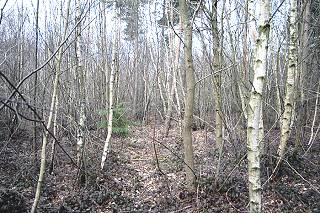
A few of the original conifers remain within this woodland which also contains occasional hornbeam, oak and aspen.
- Grid reference: TR 133 629
- Original conifer species: Corsican pine
- Current trees: Birch with some oak and other species
- Ground flora: Predominantly bramble, bracken and honeysuckle
Darwell
Regeneration following Great Storm of October 1987
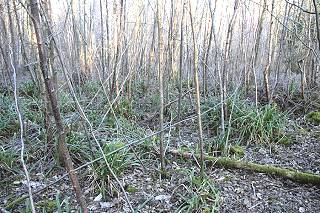
This site had more than 20 species in the ground flora including the pendulous sedge visible in this picture.
- Grid reference: TQ 706 199
- Original conifer species: Douglas fir
- Current trees: Dominated by birch, but small amounts of hornbeam and sweet chestnut coppice
- Ground flora: Predominantly bramble, but wood sage, pendulous sedge and broad buckler fern common
Dene Park
Regeneration following Great Storm of October 1987
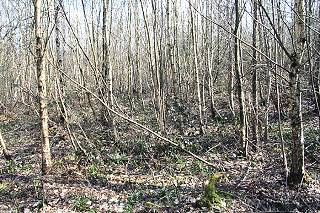
Typical of these naturally regenerated sites this young woodland dominated by birch. There is a sparse ground flora containing bramble and at this site bluebells can be seen emerging.
- Grid reference: TQ 598 516
- Original conifer species: Norway spruce
- Current trees: Birch with small amounts of hornbeam and chestnut
- Ground flora: Predominantly bramble, bracken and bluebell
Hemsted
Regeneration following Great Storm of October 1987
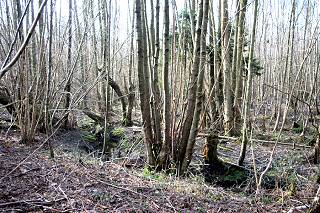
Old coppice stools of alder are present beside the stream that runs through this wood.
- Grid reference: TQ 824 354
- Original conifer species: Norway spruce
- Current trees: Birch with some other species
- Ground flora: The most common species are bramble, broad buckler fern and wood sage.
Mopesden
Regeneration following Great Storm of October 1987
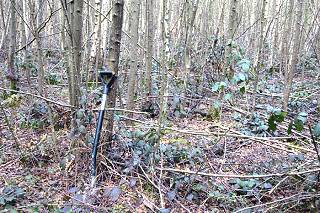
Competition between trees has begun to cause death of small trees in this dense stand of birch.
- Grid reference: TQ 741 317
- Original conifer species: Scots pine
- Current trees: Birch with occasional sweet chestnut
- Ground flora: Bramble, broad buckler fern and wood sage are the most frequent species.
Orlestone
Regeneration following Great Storm of October 1987
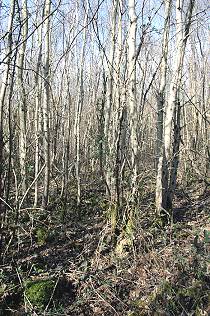
Small patch of aspen amongst a dense stand of birch.
- Grid reference: TQ 986 356
- Original conifer species: Norway spruce
- Current trees: Birch with some aspen, oak and hornbeam
- Ground flora: Bramble, honeysuckle and wood sage with a few other grasses and herbs
Research into the effects of the Great Storm of October 1987
Consequences of wind damage
Wind damage is a natural mechanism which can have important consequences for the ecology of woodlands. For example it can:
- Create gaps that allow the regeneration of trees and shrubs
- Produce open space and bright, sunny, warm conditions that allow flowers, butterflies and other insects to flourish
- Encourage the development of shrub habitats that will benefit birds and small mammals
- Provide deadwood (PDF-1830K) following the death of stumps, trunks and branches.
Woodlands and trees are regularly damaged by wind, but its effects are often localised with few trees suffering badly. The damage frequently goes unnoticed and whilst it is important for woodland regeneration and biodiversity it has been studied relatively rarely in Britain.
Initial research
The damage caused by the October 1987 storm was widespread, very obvious and initiated a flurry of interest amongst ecologists with more than 20 studies being established in the immediate aftermath of the storm. Early results from many of these were published (see below) in the mid-1990s and subsequently there have been several reports from longer-term studies, a list of selected publications is available.
Studies carried out by Forest Research have concentrated on the natural regeneration of trees within damaged woodlands.
Selected list of references relating to research following the 1987 storm
Anon. (1988). The effects of the Great Storm. Report of a Technical Co-ordination Committee and the Government’s response. HMSO, London. 45p.
Grayson, A. J. (1989). The 1987 Storm: Impacts and Responses. Forestry Commission Bulletin 87, HMSO, London, UK, 46p.
Harmer, R. (2002). Restocking after storm damage from an English perspective. In: A. Brunner (ed) Restocking of storm-felled forests: new approaches. Proceedings of an international workshop in Denmark, March 2001. Danish Centre for Forest, Landscape and Planning, Report No. 12, Hørsholm, Denmark, 47-51.
Harmer, R. and Morgan, G. (2009). Storm damage and the conversion of conifer plantations to native broadleaved woodland. Forest Ecology and Management, 258, 879-886.
Harmer, R., Tucker, N. and Nickerson, R. (2004). Natural regeneration in storm damaged woods – 1987 storm sites revisited (PDF-221K). Quarterly Journal of Forestry, 98, 183-190.
Kirby, K. J. and Buckley, G. P. (eds) (1994). Ecological responses to the 1987 Great storm in the woods of south-east England. English Nature Science No. 23, English Nature, Peterborough, UK, 170p.
Mountford, E. P. (2002). Storm-damage and natural regeneration in Shellem Wood, an ancient semi-natural beechwood in south-east England. Quarterly Journal of Forestry, 96, 195-204.
Mountford, E. P. and Peterken, G. F. (2000). Natural developments at Scords Wood, Toy’s Hill, Kent, since the Great storm of October 1987. English Nature Research Reports No. 346, 27p.
Mountford, E. P. and Peterken, G. F. (2001). Long-term changes in an area of The Mens, a minimum intervention woodland damaged by the Great Storm of 1987. English Nature Research Report No. 435.
Spencer, J. W. and Feest, A. (eds) (1994). The rehabilitation of storm-damaged woods. Bristol University Department for Continuing Education, Bristol, UK, 92p.
Whitbread, T. (1991a). When the wind blew, Royal Society for Nature Conservation, Lincoln, UK. 61p.
Whitbread, A. M. (1991b). Research on the ecological effects on woodland of the 1987 storm. Research and Survey in Nature Conservation No. 40, Nature Conservancy Council, Peterborough, UK, 102p.
Whitbread, A. M. (1994). Surveys of storm-damaged woods set up in 1987-88. In: K. J. Kirby and G. P. Buckley (eds) Ecological responses to the 1987 Great Storm in the woods of south-east England. English Nature Science 23, English Nature, Peterborough, UK, 24-31.
